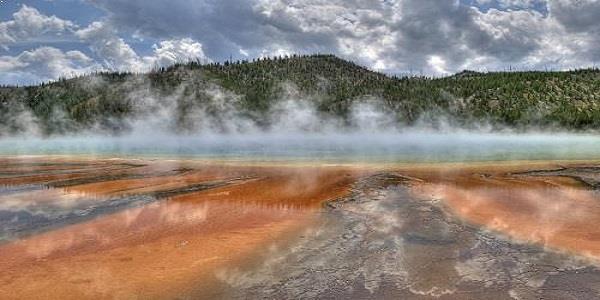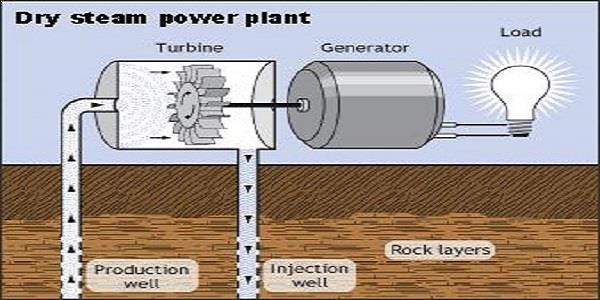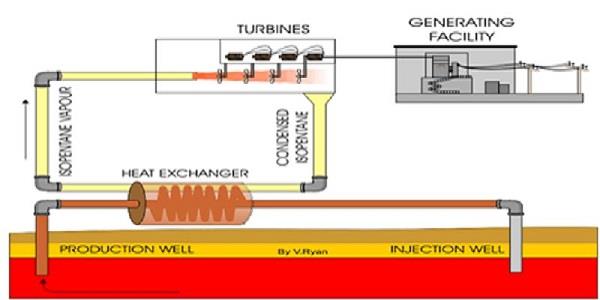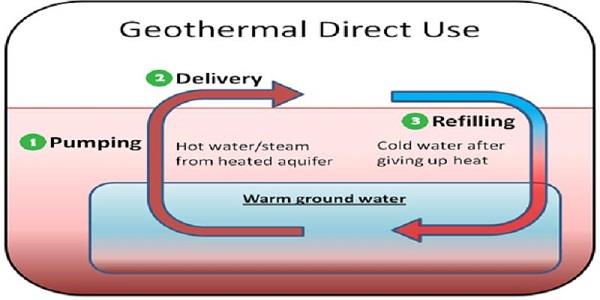Geothermal energy is the energy from the earth. The word geothermal is broken down into “geo” which means earth and “thermal” which means heat.
This energy is part of renewable energies such as wind and solar and is touted as the best forever-available energy because the temperature beneath the earth remains constant.

Geothermal energy has been harvested for thousands of years ago by our ancestors. It was mainly used for cooking, heating, and bathing.
As years have gone by, scientists started to realize the versatility of this energy to the extent of producing electricity to replace part of fossil-fuel generated power. This energy is clean and releases only about 1% of the gases emitted by fossil-fuel power generators.
In 1904, Italian scientists became the first to design and install the geothermal power plant in Larderello. Then the United States followed although their first attempt had failed. Today, many countries have come to the forefront of utilizing the energy beneath the earth’s crust for various applications.
Temperatures in the earth’s core – a layer beneath the earth’s crush are extremely hot. It is this constant supply of heat that makes geothermal energy to be renewable and sustainable.
Modern technologies have found ways to pump liquid from and into the geothermal reservoirs to generate power and heat homes.
In this article, I explain everything you need to know about geothermal energy from geothermal energy basics, applications, geothermal energy pros, and cons as well as the annual consumption in various countries that include the US, UK, Canada, and Australia. I will also discuss how geothermal energy works and the cost thereof when installing the power plant.
Geothermal Energy Basics
How is geothermal energy generated?
This is probably the first question that comes to every inquisitive mind about renewable energies.
This energy is generated by harvesting heat from underground and pumping it through the pipes installed meters down the ground. The energy is extracted from hot water or steam reservoirs beneath the earth by drilling wells.
The hot water stream is used to activate the turbines that subsequently produce electricity to feed the utility grid network to the end-users.
Other uses include using the geothermal hot water pumps to heat homes, hospitals, schools, and business sites. Furthermore, the heat can be used directly without the use of heat generators to heat or cool buildings.
Uses & Applications
Geothermal energy has many uses across the world.
Some of the geothermal energy examples include the lava that ejects steam and hot occasionally, hot springs, and geysers. They bear witness that indeed geothermal energy is effective. This energy can be used in many applications that require heat.
These include heating homes, heating swimming pools, cooking, bathing, and other industrial processes. In a nutshell, the geothermal energy is used to generate electricity or provide heat.
1). Electricity Production
Modern technologies have given us the opportunity to generate electricity out of hot water and steam extracted from beneath the earth’s surface.
Power plants are used to produce electricity by activating the turbines by steam.
There are basically three ways, viz. dry steam plants, flash plants, and binary plants, which are used to generate this power. These three methods are explained subsequently.
Dry steam method
In dry steam plants, the hot steam is pumped directly into the power plant to turn the turbine which will then produce electricity.
This steam is taken from the hot water from geothermal reservoirs.
Check the photo illustration which shows how this steam produces electricity by turning the turbine which will turn the generator and ultimately produce electricity. The dry steam plant basically uses hydrothermal fluids from the ground.

Flash method
Flash steam plants are the most common in the industry.
Basically, hot water (usually ranging from 300 to 700 degrees Fahrenheit) is pumped through wells installed underground. When this water turns into steam, the steam is used to turn the turbine to generate electricity.
Some of the steam will cool and condense into the well to return to the ground. The process is continuous hence the energy is considered to be renewable and sustainable.

Binary cycle
These plants use a different liquid with a lower boiling point than water.
The liquid is often isobutene which is used to extract heat and then evaporates to form steam that will turn the turbines and then generate power.
The geothermal water at low temperature is pumped through the heat exchanger which will transfer heat to isobutene. This liquid will then boil. See the picture below that illustrates the process.

All these types of geothermal plants do not require much of the land when installed. A ton of the geothermal unit could require about 140 feet (42.7 Meters) and the space between the units if you are installing more than one should be 15 feet (4.6 Meters).
If, for example, you plan to install three ton of geothermal units, you would need 140 feet by 30 feet (42.7 * 9 Meters).
Cost-wise, it depends on the type of loop or plants you decide to install. A geothermal power plant could cost around $3400 per kilowatt. A complete installation includes the ground loop (either open or closed loop) and the heat pump or generators.
On average, the owner might spend around $7500 for the geothermal power plant. Consider all other equipment and the making of excavations in your price calculations.
You might even pop out about $20 000. While the initial installation costs are exorbitant more than those of alternative fossil-fuel based sources, geothermal energy production will save you lots of energy bills in the long run.
When comparing the loops, vertical loops are expensive over horizontal ones. It could cost around $1500 per ton of vertical whereas a horizontal loop can cost around $800. The vertical loop is used when the land is inadequate for the horizontal loop.
2). Geothermal energy in heating
For many years ago, the main use of geothermal energy was through heating and cooling homes. That functionality is still continuing on today with more advanced technologies.
There is a direct use where heat is produced directly from the hot water and there is an extraction of heat through geothermal heat pumps. I shall discuss that below.
Direct Use: Producing heat directly from hot water
The hot water can be drawn through pipes into the homes to heat them. There is a heat exchanger which facilitates this heat transfer to the air and heat the home.
In summer the reverse occurs where the water draws heat from your home to the ground. A direct pumping of water is more feasible in regions where geothermal reservoirs or hot springs are near the earth’s surface.
After heating the home, the water is taken back to the well to be reheated. The process continues forever without depleting your additional water sources. The picture below illustrates that:

Using Geothermal Heat Pumps
How is geothermal energy used in homes?
Today, heat pumps are popular in heating many homes, and they save homeowners lots of money annually. The temperature beneath the earth remains constant throughout the year, so it can be reliable to heat homes.
There are pipes installed underground to achieve this mission by letting the fluid circulate through the pipes into the home. A heat exchanger and electric compressor are used to extract this heat and send it through the duct system in your home.
The picture below demonstrates this process in a nutshell:

This geothermal heat pump (ground source heat pump) system basically uses the earth as the heat source in inclement temperatures and as a heat sink during hot days.
The same process channel of heating a home can cool this home by extracting heat from it to the ground. The interesting thing about the system is that it doesn’t have to burn fossil fuels.
Although the initial costs may be overwhelming, the geothermal heat pumps will save you more money in the long run. The costs vary subject to the type of loop installed.
If, for example, you have a home size of 2500 square feet and it consumes 60000 BTU, you could spend around $20 000 for the installation of the geothermal heating unit.
Moreover, there is little maintenance on this system. The indoor components of this system can last you up to 25 years while the ground pipes can last you about 50 years. This is a system that can solve your energy bills.
How can Geothermal boost your property’s value?
Pros and cons of geothermal energy
Geothermal energy is renewable and sustainable energy with loads of benefits. However, it is also subject to some cons like any other renewable energy source. I will discuss the pros and cons below:
Pros:
- Firstly, geothermal energy is renewable and sustainable. The temperature of hot water beneath the earth’s crush or earth’s core does not fluctuate the same way the sun and wind do.
Compared with wind energy and solar energy, geothermal energy is not intermittent. We will still have that hot water for billions of years to come. The water drawn from the ground can be replenished because the main thing we want is steam. - It is almost available in all regions. Every country can leverage on this energy source.
- It requires small land for installation. Unlike the wind farm or solar plants, geothermal horizontal or vertical loop systems require only little land.
- Fewer emissions – The hot water from the ground will release only small percentages of hydrogen sulfide into the atmosphere. The traces of methane as well could be problematic. However, the good side is that it emits a very small percentage compared to fossil fuels. The binary cycle plant, in contrast, does not emit any gas.
- Little maintenance
- Can solve heating and cooling problems of your home and replace the conventional HVAC systems
- No monthly bills
- Governments give away incentives for anyone planning to install geothermal energy. Countries such as the UK and the US are encouraging people to establish geothermal energy projects.
- Insignificant carbon footprint
- The system lasts for many years. The indoor components last for about 25 years whereas, the ground components last for about 50 years.
Cons:
- Setup costs are exorbitant
- Emit hydrogen sulfide which will turn into sulfur dioxide in the atmosphere
- Installation sites required in isolated areas so more costs of transmitting that power to the utility grid could be cumbersome.
- An open loop system could replenish your fresh water. But because the water from underground is unclean, it is not necessary to refill with clean water either.
- Drilling wells into a heated rock are challenging
- Large scale geothermal plants can be damaging to the earth when you may have to drill many deep wells.
Environmental Effects
Geothermal energy has some environmental effects although not as detrimental as fossil fuel energy generation.
The notable effects are on the quality of water, land requirements and air emissions.
Water Quality
When using this system, you may have to pump water into the ground for it to extract water if you are using an open loop system.
This will deplete your water sources and have an environmental effect on the scarcity of water in your area.
However, a closed loop system pumps the water back into the ground although not the same volume because some of it has been lost through the steam which activated the turbines to produce electricity.
The open-loop water is ejected to the environment and has high quantities of sulfur and other minerals. In fact, it can contaminate other water sources in the vicinity.
Air emissions
Although there are some emissions of gases in an open-loop system, the levels are not comparable to fossil fuels. It could be only about 1 to 3% of the amount emitted by other conventional energy sources.
The gases emitted by the open-loop geothermal system include carbon dioxide, ammonia, hydrogen sulfide, boron, and methane. A rotten egg smell detects the hydrogen sulfide.
When it reaches the atmosphere, it turns into sulfur dioxide which can cause acid rain that can affect your crops badly.
Land requirements
Geothermal energy needs land to install but this is not as huge as other sources such as wind farm and solar plants. This land demand differs depending on the type of system you plan to install.
The largest geothermal plant is the Geysers in California with 78 square kilometers of land occupied. It generates about 1517 megawatts of power. Multiple geothermal plants installed could demand a larger land.
Geothermal Energy – Facts and Figures
Geothermal energy figures and statistics differ from one country to the other.
In the United States, about 15.98 billion kilowatt hours were generated in the year 2017. This gives an approximate projection of how much the country produces yearly. Western states and Hawaii remain the most popular regions where geothermal energy is predominantly used. The total capacity of geothermal energy plants in the US amounts to 3200 megawatts which can power over 3 million homes. Among other states, California generates 6% more of geothermal energy.
The UK, on the other hand, has a potential of 100GW of geothermal energy. By 2030 the country has an objective to develop 2.2 GW. The country has introduced the Renewable Heat Incentive in 2011 which encourages many people to tap the geothermal energy sources. To reach its target by 2030, the country will invest about UK£3 billion. Of course, this will contribute to an increase in employment.
Australia’s size of geothermal energy resource is uncertain due to the lack of information about the temperatures underground. However, Geoscience Australia has estimated the amount to be 1.9 x 1010 PJ for temperatures over 150 C.
The world is already exposed to 10 000 megawatts of geothermal energy which can power over 10 million households. The number could increase in the near future.
Potential
Experts are regarding geothermal energy as the third most significant and major renewable energy after solar and wind.
There is a positive outlook on the future of geothermal energy. Experts expect a yearly capacity of 12.6 GW to 21.5 GW and that can skyrocket from 2018 to 2020.
[content_band border=”all” inner_container=”true”] [custom_headline style=”margin-top: 0;” level=”h4″ looks_like=”h3″]Statistical References[/custom_headline]- Geothermal electricity generation in the United States from 2005 to 2017
- What is geothermal- Geothermal in the UK
- Geothermal Power in Australia [PDF]
- Geothermal Power: A no-brainer for Canada?
- Future of Geothermal Industry Becoming Clearer [Worldwide]
Wrapping up!
Geothermal energy is a type of energy that can save the country and its citizens a great deal of money. The energy is from underground which is constant throughout the year.
That being said, it is reliable, renewable and sustainable for many years to come. Other parts of the world are already heavily relying on geothermal energy to heat residential and commercial buildings. The setup is easy with the power of hot water and steam.
The hot water is also used in generating power which can be used in many applications. However, the costs of installation are high. The good thing is that it qualifies for tax incentives and governments also facilitate funding for initiatives.
I have explored the topic of geothermal energy. By now, I believe you are equipped with full knowledge to undertake these projects. I have discussed the pros and cons to help you weigh your options.

Comments
You’ve covered almost everything about geothermal power. I have a question though, How efficient geothermal heat pumps are during winter?
They are as efficient as they are in summer. The temperature underneath the ground does not change. Please read the article : Geothermal heat pumps guide for further details.